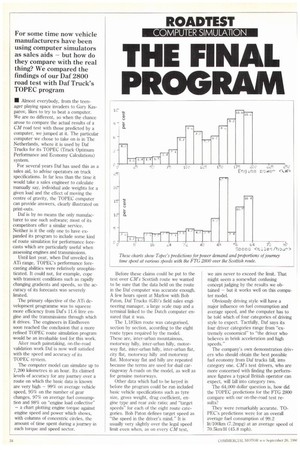THE FINAL PROGRAM
Page 36

If you've noticed an error in this article please click here to report it so we can fix it.
For some time now vehicle manufacturers have been using computer simulators as sales aids — but how do they compare with the real thing? We compared the findings of our Daf 2800 road test with Daf Truck's TOPEC program
• Almost everybody, from the teenager playing space invaders to Gary Kasparov, likes to try to beat a computer. We are no different, so when the chance arose to compare the actual results of a CM road test with those predicted by a computer, we jumped at it. The particular computer we chose to take on is in The Netherlands, where it is used by Daf Trucks for its TOPEC (Truck Optimum Performance and Economy Calculations) system.
For several years Daf has used this as a sales aid, to advise operators on truck specifications. In far less than the time it would take a sales engineer to calculate manually say, individual axle weights for a given load and the effect of moving the centre of gravity, the TOPEC computer can provide answers, clearly illustrated on print-outs.
Daf is by no means the only manufacturer to use such software; most of its competitors offer a similar service. Neither is it the only one to have expanded its program to include some kind of route simulation for performance forecasts which are particularly useful when assessing engines and transmissions.
Until last year, when Daf unveiled its ATi range, TOPEC's performance forecasting abilities were relatively unsophisticated. It could not, for example, cope with transient conditions such as rapidly changing gradients and speeds, so the accuracy of its forecasts was severely Limited.
The primary objective of the ATi development programme was to squeeze more efficiency from Daf's 11.6 litre engine and the transmissions through which it drives. The engineers in Eindhoven soon reached the conclusion that a more refined TOPEC route simulation program would be an invaluable tool for this work.
After much painstaking, on-the-road validation work Daf is now well satisfied with the speed and accuracy of its TOPEC system.
The computer model can simulate up to 7,200 kilometres in an hour. Its claimed levels of accuracy for any journey over a route on which the basic data is known are very high — 99% on average vehicle speed, 95% on the number of gear changes, 97% on average fuel consumption and 98% on "engine load collective" — a chart plotting engine torque against engine speed and power which shows, with columns of concentric circles, the amount of time spent during a journey in each torque and speed sector. Before these claims could be put to the test over CM's Scottish route we wanted to be sure that the data held on the route in the Daf computer was accurate enough. A few hours spent at Marlow with Bob Paton, Daf Trucks (GB)'s field sales engineering manager, a large scale map and a terminal linked to the Dutch computer ensured that it was.
The 1,1811un route was categorised, section by section, according to the eight route types required by the model. These are, inter-urban mountainous, motorway hilly, inter-urban hilly, motorway flat, inter-urban hilly, inter-urban flat, city flat, motorway hilly and motorway flat. Motorway flat and hilly are repeated because the terms are used for dual carriageway A-roads on the model, as well as for genuine motorways.
Other data which had to be keyed in before the program could be run included basic vehicle specifications such as tyre size, gross weight, drag coefficient, engine type and rear axle ratio; and "target speeds" for each of the eight route categories. Bob Paton defines target speed as "the speed in the driver's mind." It is usually very slightly over the legal speed limit even when, as on every CM test, we aim never to exceed the limit. That might seem a somewhat confusing concept judging by the results we obtained — but it works well on this computer model.
Obviously driving style will have a major influence on fuel consumption and average speed, and the computer has to be told which of four categories of driving style to expect. Tactfully, Dal says its four driver categories range from "extremely economical" to "the driver who believes in brisk acceleration and high speeds."
The company's own demonstration drivers who should obtain the best possible fuel economy from Daf trucks fall, into category one. CM's test drivers, who are more concerned with finding the performance figures a typical British operator can expect, will fall into category two.
The 64,000 dollar question is, how did the TOPEC predictions for the FTG 2800 compare with our on-the-road test results?
They were remarkably accurate. TOPEC's predictions were for an overall average fuel consumption of 99.2 fit/1001cm (7.2mpg) at an average speed of 70.5km/H (45.8 mph).
























































































































